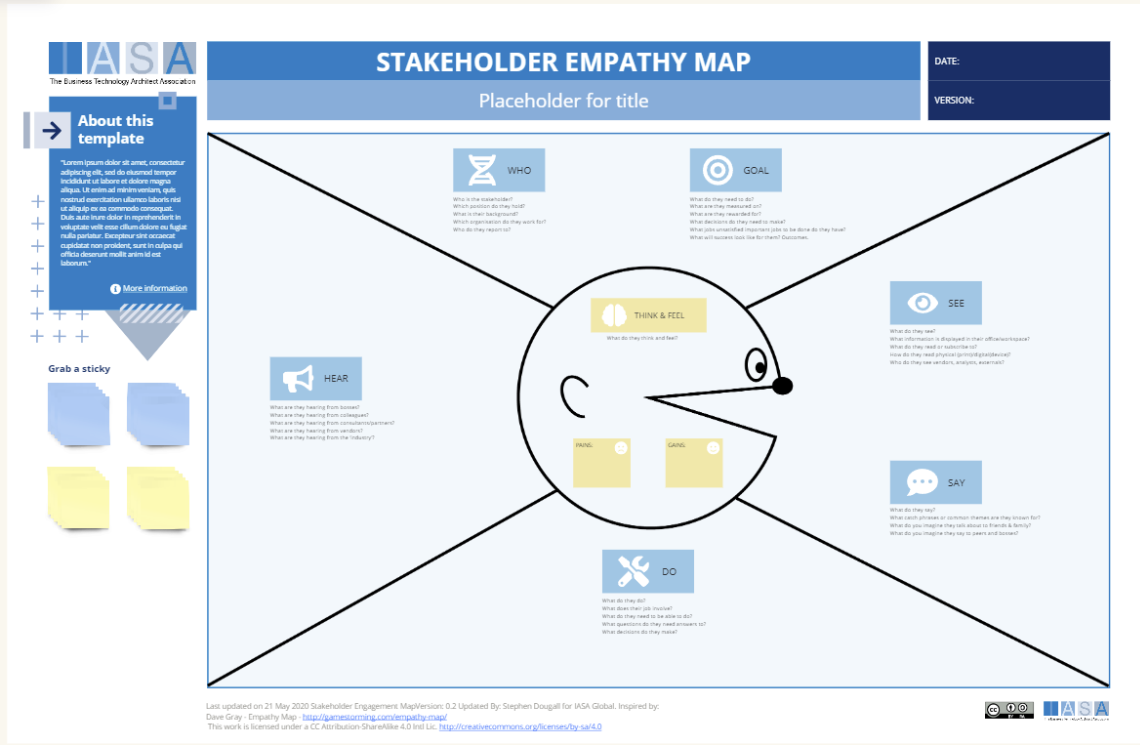Overview
An empathy map is a collaborative tool used to understand the thoughts, feelings, and experiences of a particular group of people. Stakeholder empathy maps are a variation of this tool that focus on understanding the perspectives of the people who will be impacted by a project or product.
Stakeholder empathy maps can be used by architects to better understand the needs of the people who will be using the buildings or spaces they design. This can help them to create designs that are more functional, user-friendly, and meet the needs of all stakeholders.
How to use this canvas
- Identify your stakeholders. The first step is to identify all of the people who will be impacted by your project. This could include clients, users, employees, regulators, and the community.
- Fill out the map. The stakeholder empathy map is typically divided into four quadrants: See, Hear, Say, and Do. In each quadrant, you should brainstorm what your stakeholders see, hear, say, and do in relation to your project. For example, in the See quadrant, you might list things like the project plans, the construction site, and the finished building. In the Hear quadrant, you might list things like conversations with the architect, presentations about the project, and feedback from the community.
- Analyze the data. Once you have filled out the map, take some time to analyze the data. What are the common themes? What are the key needs and concerns of your stakeholders?
- Use the insights to inform your design. The insights from your stakeholder empathy map can be used to inform your design decisions. For example, if you learn that your stakeholders are concerned about the amount of traffic that the project will generate, you may need to design a plan to mitigate that impact.
Downloads
Canvas Details
| Area | Description | Links To |
|---|---|---|
| Who/What are we empathizing with? | The need is a description of the drivers for the project. It should be driven from OKRs and should not include any of the approach section or proposed solution. | Persona Card |
| Says | List the things you might hear them say; this includes direct quotes, complaints, praise, and even potential online comments. | Persona Card |
| Does | Focus on actions. What tasks do they perform related to your project or product? How do they interact with your systems or services? | Persona Card |
| Thinks | What might be on their mind? Worries, desires, questions, and assumptions they hold about the project/product. | Persona Card |
| Feels | The emotional state is key. Are they enthusiastic, frustrated, fearful, skeptical? List both positive and negative feelings. | Persona Card |
| Pains | Specific challenges, obstacles, or frustrations that negatively impact your stakeholder. | Persona Card, Value Designer |
| Gains | The desired outcomes, benefits, and positive motivators your stakeholder seeks. | Persona Card, Value Designer |
Use this in Miro
We in the BTABoK are so very excited about the native support for architecture canvases in Miro! Find this canvas in the Miroverse!

##
